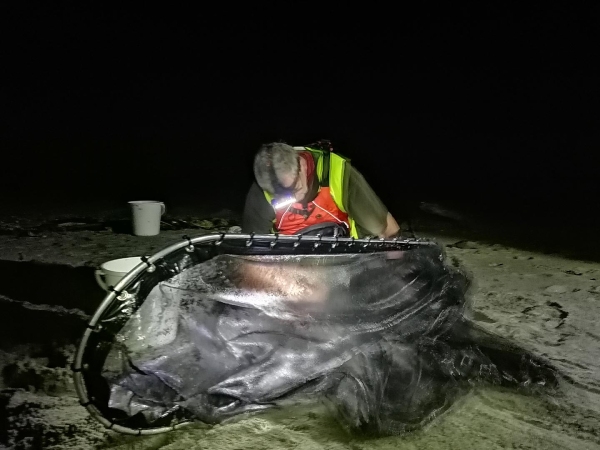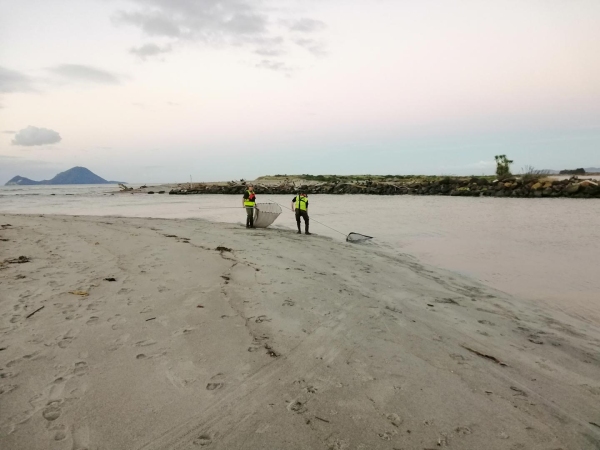Under the light of the moon where the river meets the sea, NIWA researchers are planning to catch tiny fish that are all but invisible to the naked eye.
Freshwater fish ecologist Dr Eimear Egan calls it “blind scooping”. “You’re standing in the surf at night, there’s no lights and you can’t see what you’re trying to catch.”
Dr Egan is leading a project to find out more about the mysterious marine lives of longfin and shortfin eels. She wants to find out where the larvae come from, which ocean currents they’re using to bring them to the New Zealand coast and whether shortfin and longfin eels use different spawning grounds and ocean currents to get here.
Eel larvae face a long journey from their spawning grounds in unknown parts of the Western Pacific Ocean to the freshwater rivers and streams of New Zealand where they spend most of their lives.
It’s a precarious journey about which, Dr Egan says, very little is known. But when the larvae near the coast, they turn into what are known as glass eels about 6cm long. It’s not until they enter freshwater that they change colour and become elvers (juvenile eels).
To find out more about the marine phase of an eel’s lifespan, Dr Egan and her team will be at three river mouths over the next five months using modified whitebait nets to scoop up the glass eels for further study.
“The bulk of them usually arrive two hours after sunset and we will be sampling when there are new and full moons and when the tides are at their highest,” Dr Egan says.
The team will also mobilise after heavy rain as glass eels may enter the freshwater network at that time. They are targeting the Rangitāiki, Grey and Ashley rivers over coming months and have discussed the work with Ngāti Awa Rangitāiki Hapū Coalition, Rangitāiki River Forum, Ngāti Waewae and Te Ngāi Tūāhuriri Tuahiwi (Ngāi Tahu).
“We are worried about changing ocean conditions – for example marine heatwaves that have occurred recently. We need to know more about what that does to New Zealand’s freshwater fish as some of them spend periods of their life at sea."
“If we can better predict the implications of these extreme events on the survival and recruitment of glass eels, then we can feed this information into population models to get a better understanding of eel stocks.”
That is partly why they have selected three locations – to ensure they include different oceanographic conditions such as temperature, prevailing currents, wind direction and speed.
The glass eels will have their earbones or otoliths extracted in a laboratory which provide vital information on growth rates, hatch dates, age and environmental history.
“Ear bones can tell us so much information about the environment a fish experiences on a daily basis. Each day they add a layer of calcium carbonate which is almost like keeping a diary of their lives.
“They tell us about their growth, their spawning and hatching dates, about the chemistry of the environment they live in, about their diet and movement. And because of that daily layer we can potentially figure out what routes the larvae took to get to the New Zealand coastline.”
There is evidence of a worldwide decline in recruitment of glass eels, particularly for the European and Japanese species. Factors contributing to this decline are likely to include climate change, loss of habitat, pollutants, over-fishing, and obstacles to migration.
Dr Egan and her colleagues will also use chemistry techniques to estimate the temperatures the larvae have experienced at sea. Dr Egan is hoping analysis of the eel tissue using compound specific stable isotopes of amino acids will help pinpoint where in the western Pacific Ocean the larvae might have come from.
In June, NIWA scientists tagged a number of female longfin eels before they left New Zealand in a related project to pinpoint their spawning grounds, which is most likely to be in a large area between Tonga and New Caledonia. Some information from the tags has been received indicating the migrating eels have not yet reached their destination.



